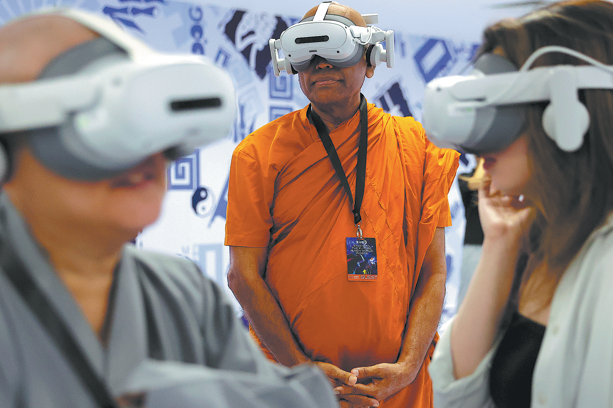Bronzes of Chinese emperors captivate Chicago
By JIAN PING in Chicago | China Daily USA | Updated: 2018-04-20 16:10
Art Institute exhibition showcases more than 180 pieces of bronze that were collected by emperors and scholars throughout history.
Chicago museum-goers are getting a chance to view some relics from the Palace Museum that have never before been seen outside of China.
Mirroring China's Past: Emperors and Their Bronzes, which opened on Feb 25, has generated much buzz and drawn many visitors to the Art Institute of Chicago (AIC).
The exhibition showcases more than 180 pieces of Chinese bronze that were collected by emperors and scholars throughout history.
"This is the largest Chinese bronze exhibition in the world," said Tao Wang, curator of the exhibition and Pritzker chair of Asian Art at AIC.
Wang said that many pieces at the exhibition come from the Palace Museum in Beijing and have never been shown outside of the Forbidden City and the Shanghai Museum.
"They are national treasures," Wang said.
James Rondeau, president of the AIC, states in a foreword that the exhibition illuminates how these works "were created and originally used" and "examines how they were collected, classified and understood" over the course of many centuries.
The exhibition fills the entire Regenstein Hall at the museum. In addition to the loans from the two major museums in China, the display also includes pieces from several US museums, including the Metropolitan Museum of Art in New York, and private collections.
Wang said that he had spent 10 years studying Chinese bronzes. He said that in an effort to make the exhibition groundbreaking, he curates the show not from the usual archaeological perspective but rather from the angle of "discovery, collecting and the use of bronzes".
"I want people to fall in love with bronzes, as it happened to me," Wang said.
Wang explained that unlike in the West, where bronzes largely were used as weapons and tools, those in ancient China were used mainly for rituals and vessels for cooking and drinking.
"China's best bronzes were made in the Shang and Zhou dynasties, so it's around 1500 BC up to the third century BC, the period when Chinese bronzes really flourished," he said.
"It's amazing to see the different finishes," said Rozanne Klinzing of Kansas City, Missouri. She made a stop in Chicago just to see the show.
"The layout is very impressive, and it's wonderful to see the items in three dimensions," she added. "I can spend the whole day here."
Wang said that he wants people to understand why the bronze is beautiful and what to look for when they go through the exhibition.
"Look at the color or colors of the bronzes and look at the different shapes and decorations," he said, walking through the exhibition. "Understand what's behind their use. They all have great stories."
Wang paused in front of a tripod cauldron in a glass case displayed against a life-sized photo of officials in the Qing Dynasty, in which the tripod and another large bronze were included. He said the cauldron is from the Palace Museum.
Pointing to a set of bronzes placed across the room, Wang said the other piece in the photo is "right over there, a loan from the Metropolitan Museum".
"It's the first time the two bronzes are together for over a hundred years," he added.
Wang said that bronze is the embodiment of ancient Chinese philosophy and moral principles.
In Chinese mythology, ancient bronze carried the mandates of the heavens. If a ruler had the merit to rule the country, he would be able to obtain and hold bronze vessels. Emperors collected and used bronzes throughout history.
The exhibition also features many items collected by emperors Song Huizong and Qianlong during the Song (AD 960-1279) and Qing (AD 1644-1911) dynasties, as well as collections from scholars during the time.
Wang titled the section for the scholars' collection "Friends and Rivals".
"In the Qing Dynasty, all the scholars and officials collected bronzes, not because they loved bronzes, but also because there was this competition," Wang said. "Collecting was a symbol of status, so there were rivalries in who could collect what."
It was also a demonstration of friendship, Wang was quick to add, pointing to the collection of bronze rubbings on display.
"When they collected something valuable, they made rubbings to give to their friends," he said.
A special video showing how the rubbings are done was being shown on a large monitor.
One of the most popular areas at the exhibition is a room where visitors can create their own rubbings against more than a dozen plates set on the tables.
Minxin Wang, a college student from New Jersey visiting Chicago during her spring break, was earnest in her bronze rubbing, along with a couple of her friends.
Klinzing said it's great to have the rubbings here.
"It's not just a hands-on fun activity, but also a learning process to experience what archaeologists do in their research," she said.
Many visitors, children and adults have pinned their rubbings on a board against the wall.
"Based on the physical forms of these early bronzes, we've grouped them into round, square and animal-shaped vessels," Wang said. "They were used for food, wine or water."
The exhibition also includes many artworks in other forms and materials that were inspired by bronzes.
The exhibition will run through May 13.























